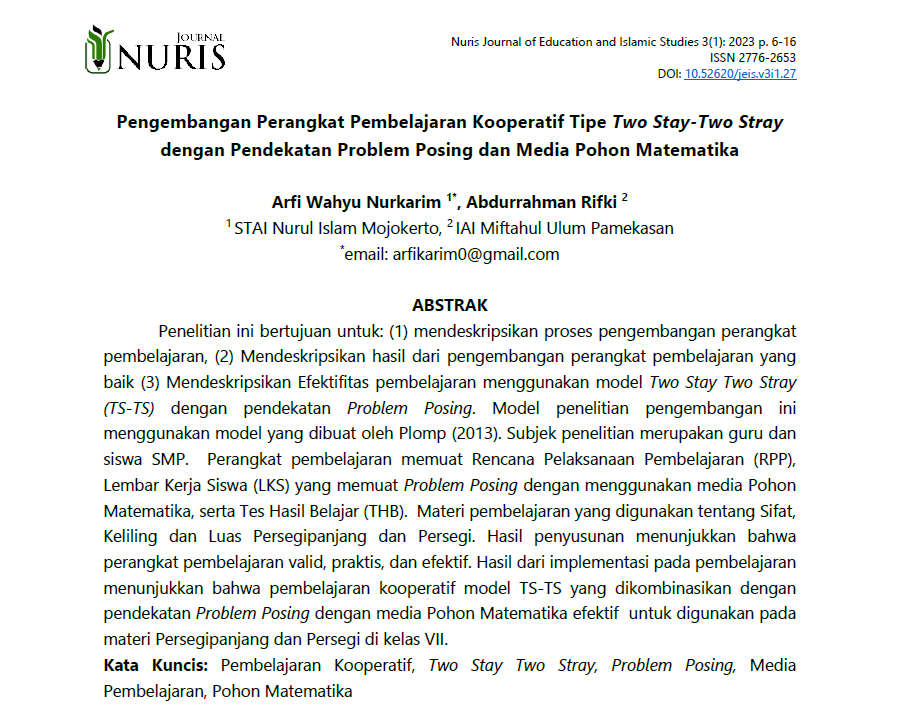Pengembangan Perangkat Pembelajaran Kooperatif Tipe Two Stay-Two Stray dengan Pendekatan Problem Posing dan Media Pohon Matematika
Main Article Content
Abstract
Penelitian ini bertujuan untuk: (1) mendeskripsikan proses pengembangan perangkat pembelajaran, (2) Mendeskripsikan hasil dari pengembangan perangkat pembelajaran yang baik (3) Mendeskripsikan Efektifitas pembelajaran menggunakan model Two Stay Two Stray (TS-TS) dengan pendekatan Problem Posing. Model penelitian pengembangan ini menggunakan model yang dibuat oleh Plomp (2013). Subjek penelitian merupakan guru dan siswa SMP. Perangkat pembelajaran memuat Rencana Pelaksanaan Pembelajaran (RPP), Lembar Kerja Siswa (LKS) yang memuat Problem Posing dengan menggunakan media Pohon Matematika, serta Tes Hasil Belajar (THB). Materi pembelajaran yang digunakan tentang Sifat, Keliling dan Luas Persegipanjang dan Persegi. Hasil penyusunan menunjukkan bahwa perangkat pembelajaran valid, praktis, dan efektif. Hasil dari implementasi pada pembelajaran menunjukkan bahwa pembelajaran kooperatif model TS-TS yang dikombinasikan dengan pendekatan Problem Posing dengan media Pohon Matematika efektif untuk digunakan pada materi Persegipanjang dan Persegi di kelas VII.
Downloads
Metrics
Article Details

This work is licensed under a Creative Commons Attribution 4.0 International License.
License Terms
In submitting the manuscript to the journal, the authors certify that:
- They are authorized by their co-authors to enter into these arrangements.
- The work described has not been formally published before, except in the form of an abstract or as part of a published lecture, review, thesis, or overlay journal.
- That it is not under consideration for publication elsewhere,
- That its publication has been approved by all the author(s) and by the responsible authorities – tacitly or explicitly – of the institutes where the work has been carried out.
- They secure the right to reproduce any material that has already been published or copyrighted elsewhere.
- They agree to the following license and copyright agreement.
References
Bonotto, C. (2010). Engaging Students in Mathematical Modelling and Problem Posing Activities. Journal of Mathematical Modelling and Application. Vol. 1, No. 3, 18-32.
Brown, S. I. & Walter, M. I. (2005). The Art of Problem Posing. New Jersey: Lawrence Erlbaum Associates, Inc
Mann, E. L. (2006). Creativity: The Essence of Mathematics. Journal for the Education of the Gifted. Vol. 30, No. 2, 2006, pp. 236–260
Plomp, T., Akker, J. V., Bannan, B., Kelly, A.E & Nieven, N. (2010). An Introduction to Educational Design Research. Netherland: Axis Media-ontwerpers, Enschede
Rusman. (2012). Seri Manajemen Sekolah Bermutu “Model-Model Pembelajaran Mengembangkan Profesionalisme Guru”. Jakarta: Raja Grafindo Persada
Sharma, Y. (2014). The Effects of Strategy and Mathematics Anxiety on Mathematical Creativity of School Students. Mathematics Education, 9(1), 25-37
Silver, E. A. (1997). Fostering Creativity Through Instruction Rich in Mathematical Problem Solving and Thinking in Problem Posing. http://www.fiz.karlsruhe.de/fiz/publications/zdm ZDM Volume 29 (June 1997) Number 3. electronic Edition ISSN 1615-679X. Download December 30, 2016

